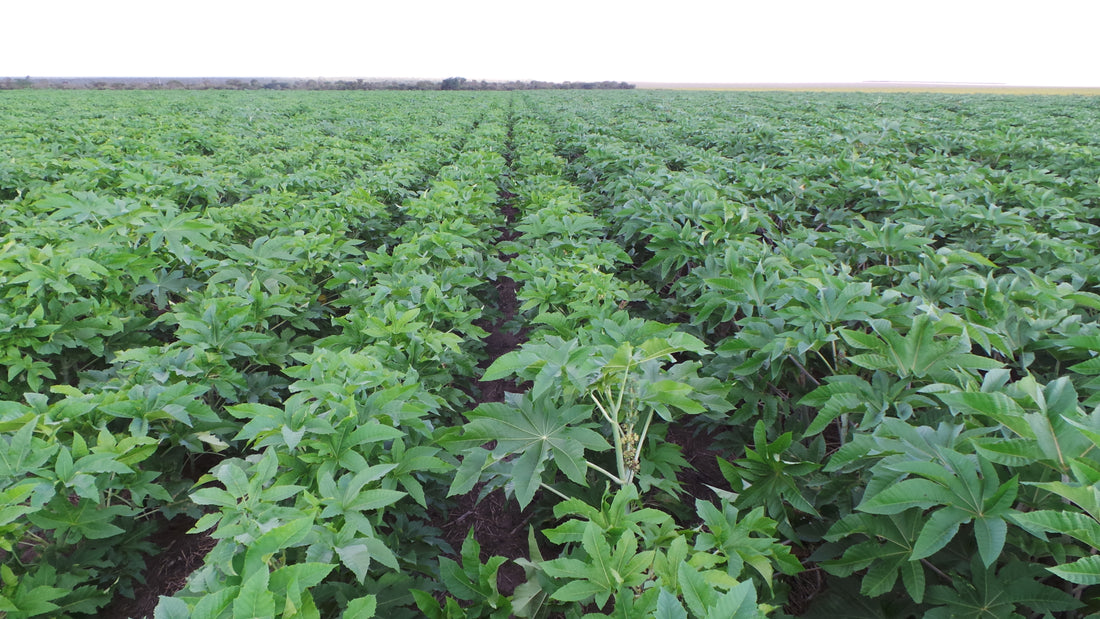
Organic Solutions for Castor Disease Prevention
Share
Introduction
Castor (Ricinus communis) is a valuable crop known for its versatile applications, from industrial uses to medicinal properties. However, like any other crop, castor plants are susceptible to a variety of diseases that can significantly impact their yield and quality. Effective disease management is crucial for ensuring the health and productivity of castor crops. This blog delves into the common diseases affecting castor plants and provides practical strategies for their prevention and control. Whether you're a seasoned farmer or a novice gardener, understanding these disease management practices will help you maintain robust and thriving castor crops.

Seedling Blight: Phytophthora colocasiae
Symptoms
The disease first makes its appearance on both the surfaces of the cotyledonary leaves in the form of roundish patch of dull green colour which soon spreads to the point of attachment causing the leaf to rot and hang down.
The infection further spreads to the stem with the result that the seedling is killed either due to the destruction of growing point or by the collapse of stem.
The true leaves of seedlings and the very young leaves of older plants may also be affected; but ordinarily not much injury is caused.
The leaf spots turn yellow and then brown and concentric zones of lighter and darker brown colour are formed.
The disease spots coalesce at a later stage and cover almost the entire leaf. The affected leaves shed prematurely.
Under moist conditions, a very fine whitish haze is found on the under-surface of the leaf spots.
In case of mature plants also the disease may spread from young leaves to the stem through the petiole.

Management
Ill drained, damp and low-lying localities should be avoided for sowing castor. Seed dressing with 4g Trichoderma viride formulation on 3g Metalaxyl per kg seed can reduce disease incidence.

Soil drenching with Anoka

Alternaria Blight: Alternaria ricini
Symptoms
All the aerial parts of the plant, i.e., stem, leaves, inflorescence and capsules are liable to be attacked.
These may appear on any portion of the leaf and are irregular, scattered, and have concentric rings.
These are brown and later become covered with bluish-green or sooty growth.
When the attack is severe the spots coalesce and form big patches resulting in premature defoliation of the plant which gradually wilts away.
In one case the capsules, when half mature, wilt suddenly, turn brown and due to collapse of the pedicel the capsules fall or hand down.
They are smaller in size and have under-developed and wrinkled seeds with little oil content.

Management
Seed treatment may be useful in combating the initial phase of the disease.
Use of healthy seed and treat the seed with Beauveria basiana

Cercospora Leaf Spot: Cercospora ricinella
Symptoms
The disease appears as minute black or brown points surrounded by a pale green ring.
These spots are visible on both the surfaces of the leaf.
As the spots enlarge, the centre turns pale brown and then greyish white surrounded by a deep brown band which may be narrow and sharp or broad and diffused.
The fructifications of the fungus appear as tiny black dots in the white centre.
The diseased spots often occur in great numbers scattered over the leaf and are roundish when young but may become irregularly angular when mature.
When the spots are close together, the intervening leaf tissue withers and large brown patches of dried leaf may result

Management:
Spraying with Bio pesticides 10–15-day interval reduces the disease incidence.
Treat the seed with Trichoderma and Pseudomonas

Conclusion
Castor farmers, beware! Disease can devastate your crop. Seedling blight, Alternaria blight, and Cercospora leaf spot are threats to watch for. Seedling blight rots young plants, while the others attack leaves, stems, and even seeds. These fungal foes can cause wilting, defoliation, and underdeveloped seeds. Fight back with a three-pronged approach: treat seeds with fungicides, spray fungicides like Mancozeb at regular intervals, and ensure good drainage to avoid fostering fungal growth. By staying vigilant and taking preventative measures, you can keep your castor crop healthy and thriving.
FAQs:
What are some organic fungicide options for managing castor diseases?
How important is proper field sanitation in preventing disease outbreaks?
Are there any biological control agents effective against these castor diseases?
